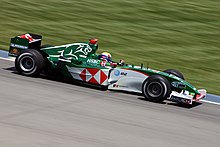
| ||||||||||||||||||||||||||||
Jaguar Racing was a Formula One team that competed in the FIA Formula One World Championship from 2000 to 2004. It was formed from the purchase by Ford of Jackie Stewart'sStewart Grand Prix Formula One team in June 1999. Ford renamed the team Jaguar Racing as part of its global marketing operations to promote their Jaguar premium car company. However, during the years of Ford's ownership, the team was unable to revive its performances of 1999.
The team in 2000 was managed by Wolfgang Reitzle, who was then head of Ford's Premier Automotive Group. The extra funding and publicity brought by becoming Ford's own team were obvious from the first race of the year. The team hired 1999 world championship runner up Eddie Irvine to partner former Stewart driver Johnny Herbert in an all UK team. Unfortunately this did not guarantee further success. The results that season did not match the results that Stewart had been able to achieve in 1999. Reitzle stepped down and was replaced by American Racing champion and successful team owner Bobby Rahal for 2001.
2001 did not see an improvement in results, and appointment of 3 time FIA F1 World Champion Niki Lauda in the middle of the year did not help team morale, with the team sliding further back in the field. An abortive attempt to bring McLaren's current technical director Adrian Newey to Jaguar further destabilised the team, and conflict between both Rahaland Lauda led to Rahal's resignation.
2002 was even worse under Lauda's stewardship, with only a resurgence later in the year in terms of results.Ford's board of directors were beginning to have major issues with the costs and benefits of running the team in Formula One, especially as it did not feature the parent company brand. Funding was reduced for 2003.Lauda and 70 other staff were made redundant, and a 2 year timeframe was given to show possible benefits.
2003 saw an improvement of form for the team, directed by John Hogan, as it benefited from good management and a more efficient usage of resources (in particular, using a wind tunnel near the factory compared to one in California). 2004 saw a stabilisation of results, but the team was unable to challenge for points on a consistent basis. Jaguar's Formula One parent company, Ford, issued a polite ultimatum as part of a reduction in sport involvement internationally. In particular, because Jaguar did not advertise the core Ford brand, there was little return of value from the enormous amount of money invested, so funding was reduced from Ford itself. Ford chose to sell the operation near the end of 2004 despite a more consistent showing in its previous two years. In mid-November 2004, energy drink companyRed Bull confirmed that they had purchased the Jaguar Formula One team from Ford as an ongoing outfit. The new team is named Red Bull Racing and used the chassis and engine that would have been Jaguar's 2005 Formula 1 challenger for its first season.
Ironically, in Jaguar's final season, the team received the most publicity when two of the team's mechanics, having won an inflatable donkey from the movie Shrek from a give-away on a fizzy drink can, photographed it around the paddock at several races and set up a website (donkeydoesf1.co.uk) for the pictures. After the 2004 Brazilian Grand Prix, Bernie Ecclestone,Max Mosley, much of the sport's management, and every driver except Michael Schumacher signed the donkey, and the mechanics announced their intention to auction it on eBay and donate the proceeds to charity. For the 2004 Monaco Grand Prix, Jaguar's cars were fitted with newly designed nose cones to promote the film Ocean's Twelve. Steinmetz Group diamonds worth in excess of $250,000 USD were attached to the nose of each car, one of which allegedly went missing afterChristian Klien's first lap crash.[citation needed]
Drivers included Eddie Irvine from 2000 - 2002, Johnny Herbert in 2000, Luciano Burti for a few races in 2001 and the Austrian GP in 2000,Pedro de la Rosa in 2001 and 2002, Antônio Pizzonia in 2003 until Hockenheim, Mark Webber in 2003 and 2004, Justin Wilson from Hockenheim to the end of 2003, and Christian Klien in 2004.
[edit]Complete Formula One results
(key)
[edit]See also
| Wikimedia Commons has media related to: Jaguar Racing |




No comments:
Post a Comment